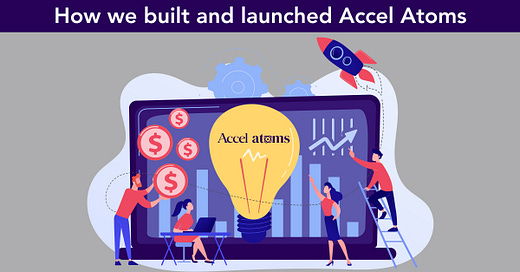I’m part of the core team that launched Atoms, Accel India’s reimagining of early stage investing, yesterday. And it’s fair to say that launch day went well.
I’ve been working on this for a few months now, along with my larger team at Accel, and it feels good to see hard work go live!


Though I can’t divulge numbers, we’ve got great feedback from founders and the ecosystem, and the way we structured the program was appreciated. We are happy, but the work has just begun.
We are looking through the startups who have applied as I write this, and we want to give the best of these young startups the best venture and mentorship experience imaginable. It’s a rather tall task, but the team is confident. I hope we are able to do all we aimed for, and give startups in the Atoms program their best shot at success.
But this dispatch isn’t about that. It’s about the back-end of the launch of a program like this, and what the marketing/PR effort for something like this entails. Again, I can’t go into minutiae. But the idea is to understand how much effort it takes to do something like this, and how early you’ve to start preparing for an announcement of this magnitude.
This list I’ve put together is by no means exhaustive, but these 5 tactics can help you as you plan your own launch. Tailor them to your context, and you'll come good.
Let’s go!
1. Aim for extreme clarity
Communication is critical when you are planning a big launch. What is in the mind of leaders is not necessarily in the minds of executioners, especially in the early stages. So much time is lost when management thinks a certain way, and you have understood it completely differently.
This gap needs to be quickly mitigated.
One way to do this is immediately put together a narrative document, share it with everyone, and write out your understanding of the final deliverables. This is basically my version of the Amazon mock press release strategy. The initial version of the narrative document is usually wrong, and everyone starts correcting until what’s left is what everyone agrees on.
2. Make a marketing plan
There are only two ways to launch anything: A big blast of an opening day, or a steady stream of constant news that keeps attention piqued over a period of time. We wanted the latter, but for weeks I couldn’t get any time to actually sit down and make a plan.
My boss at Accel, Prayank, came to my rescue, and made a clear sheet of things that we needed to do over a period of time. Now I had a clear idea of what to work on, and I could mix and match. When in execution mode, a plan like this can simplify everything. All you need to do is keep executing, which I did.
3. Go one step deeper
When planning marketing activities, never go with the first option that comes to mind. I’m vulnerable to this because I think in terms of marketing output.
But there are people on my team who challenge me to think just that bit deeper. One is Prayank, of course, and the other is Siddharth Ram, entrepreneur-in-residence at Accel, and my partner-in-crime in most marketing activities. He is never satisfied with just that first idea, constantly challenging me to dig a level deeper and see what we can change, what we can elevate.
Most of my best creative ideas are just him pushing me. Find this person for yourself, or for your team. It makes a huge difference.
4. Decide what the best outcome looks like
One way to align the entire team is to keep asking what the best outcome looks like. This is mostly an exercise in expectation management, and I have always suggested this as a great question for one on ones.
In launches and projects, having an idea of what the best case scenario looks like allows people to work towards that, and also sets up measurables. We actually did not explicitly have a discussion about this for Atoms, but all of us knew what we wanted, so that helped. One caveat with this approach is that what gets measured gets done, and everything else gets neglected. Don’t let that happen.
5. PR outreach and follow-up
Most launches have a PR angle. You launch something, and want the world to notice. I’ll tell you again what I have said before on the newsletter: Tell a story. And most often a story means pitting yourself against a competitor or an opposing idea. Don’t shy away from this.
Stories by definition have protagonists and antagonists. And without them both, nothing is memorable, Your news alone is just an announcement. Your news with context and competition is a story. Use that to your advantage.
More tactically: In a supercharged media climate like this, get an exclusive, and hope others pick it up. If it’s a slow news month, then aim at getting breadth of coverage. Offer each media outlet something they like, you can even offer them interviews you haven’t offered to others. And yes, keep following up.
Remember: We are marketers, we have no shame.
Note for early stage startups and founders: Atoms, Accel’s pre-seed program is live, and accepting applications!
Here’s what you get with Atoms: First, $250K in non-dilutive capital. The next thing we built into Atoms is a one-of-a-kind mentorship program. And finally, Atoms startups will have access to every resource and all the support that the Accel portfolio gets.
Neat, no?
It has been super-satisfying to build this for our ecosystem, and if you want to be part of this or know anyone who wants to be, here’s the link again. Apply, and ask folks to apply!



